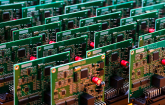MILPITAS, Calif., April 9, 2025 /PRNewswire/ -- Worldwide sales of semiconductor manufacturing equipment increased 10% to $117.1 billion in 2024 from $106.3 billion in 2023, SEMI, the industry association representing the global electronics design and manufacturing supply chain, reported today. The data is now available in the Worldwide Semiconductor Equipment Market Statistics (WWSEMS) report.
In 2024, the global front-end semiconductor equipment market experienced notable growth, with sales of wafer processing equipment increasing by 9% and other front-end segments rising by 5%. This growth was largely fueled by heightened investments in expanding capacity for both leading-edge and mature logic, advanced packaging, and high-bandwidth memory (HBM), alongside a significant rise in investments from China.
The back-end equipment segment, after two consecutive years of decline, saw a robust recovery in 2024, driven by the increasing complexity and demands of AI and HBM manufacturing. Assembly and packaging equipment sales increased by 25%, while test equipment billings rose by 20% year-over-year, reflecting the industry's push toward supporting advanced technologies.
"The global semiconductor equipment market surged by 10% in 2024, rebounding from a slight dip in 2023 to reach an all-time high of $117 billion in annual sales," said Ajit Manocha, SEMI President and CEO. "Industry spending on chipmaking equipment in 2024 reflects a dynamic landscape shaped by regional investment trends, technological advancements in logic and memory, and the rising demand for chips related to AI-driven applications."
Regionally, China, Korea, and Taiwan remained the top three markets for semiconductor equipment spending, collectively accounting for 74% of the global market. China solidified its position as the largest semiconductor equipment market, with investments surging 35% year-over-year to $49.6 billion, driven by aggressive capacity expansion and government-backed initiatives aimed at bolstering domestic chip production. Korea, the second-largest market, saw a modest 3% increase in equipment spending, reaching $20.5 billion, as memory markets stabilized and demand for high-bandwidth memory soared. In contrast, Taiwan experienced a 16% decline in equipment sales, falling to $16.6 billion, reflecting a slowdown in demand for new capacity.
Elsewhere, North America recorded a 14% rise in semiconductor equipment investments, reaching $13.7 billion, driven by increased focus on domestic manufacturing and advanced technology nodes. The Rest of the World saw a 15% increase, with billings at $4.2 billion, supported by emerging markets ramping up chip production. However, Europe faced a significant 25% decline in equipment spending, falling to $4.9 billion, due to weakened demand in the automotive and industrial sectors amid economic challenges. Japan also saw a slight 1% dip, with sales at $7.8 billion, as the region grappled with slower growth in key end markets.
Compiled from data submitted by members of SEMI and the Semiconductor Equipment Association of Japan (SEAJ), the WWSEMS report is a summary of the monthly billings figures for the global semiconductor equipment industry.
The SEMI Equipment Market Data Subscription (EMDS) provides comprehensive market data for the global semiconductor equipment market. The subscription includes three reports:
- Monthly SEMI Billings Report, a perspective on equipment market trends
- Monthly Worldwide Semiconductor Equipment Market Statistics (WWSEMS), a detailed report of semiconductor equipment billings for seven regions and 24 market segments
- SEMI Semiconductor Equipment Forecast, an outlook for the semiconductor equipment market
Download a sample of the EMDS report.
For more information about the report or to subscribe, please contact the SEMI Market Intelligence Team at mktstats@semi.org. More details are also available on the SEMI Market Data webpage.
About SEMI
SEMI® is the global industry association connecting over 3,000 member companies and 1.5 million professionals worldwide across the semiconductor and electronics design and manufacturing supply chain. We accelerate member collaboration on solutions to top industry challenges through Advocacy, Workforce Development, Sustainability, Supply Chain Management and other programs. Our SEMICON® expositions and events, technology communities, standards and market intelligence help advance our members' business growth and innovations in design, devices, equipment, materials, services and software, enabling smarter, faster, more secure electronics. Visit www.semi.org, contact a regional office, and connect with SEMI on LinkedIn and X to learn more.
Association Contact
Sherrie Gutierrez/SEMI
Phone: 1.831.889.3800
Email: sgutierrez@semi.org
Photo - https://mma.prnewswire.com/media/2660501/SEMI_Equipment_Market_Revenue_2024_cn.jpg
Logo - https://mma.prnewswire.com/media/469944/Semi_Logo.jpg






Share this article